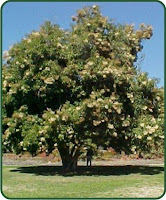 The beautiful Nuxia floribunda is becoming increasingly popular as a decorative, evergreen specimen tree. The Forest Elder bears handsome, fragrant, creamy-white flower clusters in autumn and winter, giving the whole tree a hazy, almost lacy beauty. This medium sized tree occurs naturally in most of the evergreen forests that are found from the Cape to Mpumalanga. As a forest subject, the Nuxia floribunda needs to be kept well watered all year round and being frost sensitive is best planted in a North or West facing situation in colder areas.
The beautiful Nuxia floribunda is becoming increasingly popular as a decorative, evergreen specimen tree. The Forest Elder bears handsome, fragrant, creamy-white flower clusters in autumn and winter, giving the whole tree a hazy, almost lacy beauty. This medium sized tree occurs naturally in most of the evergreen forests that are found from the Cape to Mpumalanga. As a forest subject, the Nuxia floribunda needs to be kept well watered all year round and being frost sensitive is best planted in a North or West facing situation in colder areas.BASIC TREE DETAILS
Botanical Name: Nuxia floribunda
Common Name: Forest Elder
Genus: Loganiaceae
RSA National Tree No’: 634
LANDSCAPING USES
The splendid Nuxia floribunda is one of our most beautiful indigenous trees and deserves to be more extensively used as a spectacular landscaping subject. With the Forest Elder’s dramatic flower flush offset by glossy green leaves, in autumn and winter, it combines well with other indigenous species in a woodland landscape. The tree is host to three species of butterflies and various insects and is consequently attractive to a variety of birds. The Nuxia floribunda looks stunning planted as an avenue along a road or driveway or in a linear formation along a border. The tree has a long slender stem with greyish brown, flaky bark which is extremely aesthetically pleasing. The Forest Elder works very well as a background in a border or as a screening plant.
TREE SPECIFICATIONS
Height: 3-10m
Spread: 4m
Deciduous/Evergreen: Evergreen
Growth Habit: Nuxia floribunda occurs in evergreen forest or forest margins from the Cape to Mpumalanga
Bark: The bark is pale grey to greyish brown and is slightly rough and fissured becoming flaky.
Foliage: The foliage of the Forest Elder grows in whorls of 3. The leaves are drooping, oblong-elliptic, measuring 5-15 x 1-5,5, are hairless, a light glossy green with a prominent midrib which is purplish in young leaves.
Flowers: The flowers which appear from May to September are creamy white, about 3mm long and are borne in much- branched sprays. The sprays are 25 – 30 cm long and appear near the ends of the branchlets, forming a large, conspicuous, fragrant and attractive mass.
Fruit: The fruit, which appears from June to October is a creamy brown ovoid capsule about 4mm long, protruding about halfway beyond the persistent calyx and splitting into four lobes when ripe.
Seed: The seeds are fine and inconspicuous and are released when the capsule splits.
GROWING REQUIREMENTS
Growing regions: The Forest Elder occurs naturally in evergreen and coastal forest or on forest margins of the south-eastern Cape, through the eastern Cape, Transkei and KZN, in Swaziland and Mpumalanga.
Growing conditions: The Nuxia floribunda should be planted in a large hole with good, enriched soil. The tree likes plenty of sun, a frost free winter and regular, deep watering.
Best season: Autumn - Winter
Hardiness: The Forest Elder is frost sensitive so, in colder areas, a position in a North or West facing protected situation is advised.
Propagation: Propagation from seed is difficult while propagation from cuttings is very successful.
Growth rate: Medium – approximately 1m per year
INTERESTING FEATURES
The pale yellow wood of the Nuxia floribunda is hard and heavy and was once used in wagon construction and is still used for fencing and general carpentry. The leaves are browsed by game. The bark is used medicinally and the Zulu people have traditionally used parts of the tree as a strengthening medicine after the death of a tribal member.

No comments:
Post a Comment